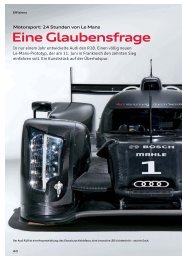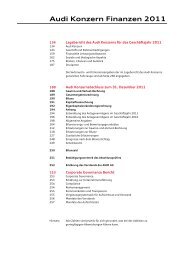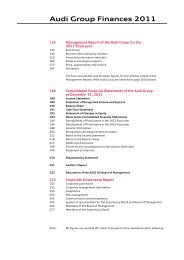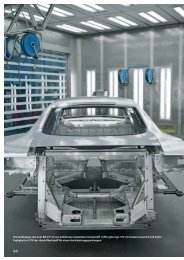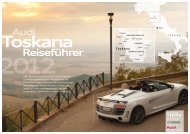within
within
within
Create successful ePaper yourself
Turn your PDF publications into a flip-book with our unique Google optimized e-Paper software.
Audi cylinder on demand<br />
The power<br />
<strong>within</strong><br />
What do the new Audi cylinder management system and biathlete<br />
Magdalena Neuner have in common? Far more than you would think.<br />
Text | Alexander von Wegner<br />
Magdalena Neuner<br />
and the Audi S6 are two<br />
model athletes<br />
with special qualities.<br />
p h o t o | tobias hase/d p a pictur e-alliance<br />
Fuel consumption and emission figures at the end of the Annual Report
Responsibility _ 97
Magdalena Neuner has perfected the transition<br />
from cross-country skiing to<br />
shooting in the biathlon over many years.<br />
Magdalena Neuner<br />
Likeable<br />
record-holder<br />
Born in 1987, Magdalena Neuner<br />
first stood on alpine skis at<br />
the age of four. She took up the<br />
biathlon when she was nine.<br />
Neuner’s career saw her go quickly<br />
from winning the German<br />
School Cup to claiming the Junior<br />
World Championship. The native<br />
of Wallgau was just 20 years old<br />
in 2007 when she took part in<br />
her first World Championships in<br />
Antholz and emerged as the most<br />
successful athlete. That same year<br />
she was named “Female Athlete<br />
of the Year.” In 2008, Neuner<br />
became the youngest biathlete<br />
ever to win the World Cup. And<br />
she was the most successful<br />
female German athlete at the<br />
2010 Winter Olympics. She set a<br />
new record by winning ten gold<br />
medals at the 2011 Biathlon<br />
World Championships. Last<br />
December, she announced her<br />
intention to end her career after<br />
the season.<br />
“I am completely<br />
happy and<br />
contented because<br />
everything is<br />
perfect, just the<br />
way I imagined it.”<br />
Magdalena Neuner<br />
The transition phase is the<br />
greatest challenge. It is<br />
difficult, but also particularly<br />
intriguing. And<br />
you have to find a very good compromise<br />
so that everything fits together,”<br />
says Magdalena Neuner. And Jürgen<br />
Königstedt agrees.<br />
The biathlete and the Head of<br />
V8/V10 Gasoline Engine Development<br />
at AUDI AG are of one mind, but with<br />
reference to two different worlds – with<br />
astonishing parallels. The professional<br />
athlete is describing the transition<br />
between cross-country skiing and<br />
shooting. The Audi engineer is talking<br />
about Audi cylinder on demand, a<br />
fascinatingly efficient solution where<br />
an eight-cylinder engine temporarily<br />
acts as a four-cylinder unit.<br />
Magdalena Neuner doesn’t need<br />
a lot of muscle to shoot. And the new<br />
Audi S6 doesn’t need eight cylinders<br />
to drive steadily at a moderate speed.<br />
Magdalena Neuner always has her<br />
muscles “on board.” Just like the<br />
Audi S6 with the eight cylinders of its<br />
4.0 TFSI engine. They are definitely<br />
needed, but are not used all the time.<br />
What sounds like a conflict of aims<br />
is cleared up when it comes to making<br />
clever use of potential. Rationing<br />
energy: muscle in the case of humans,<br />
fuel in the car. Cross-country skiing<br />
is all about time; shooting is about<br />
precision. When the Audi S6 performs<br />
an impressive sprint with eight cylinders,<br />
it saves time. With four cylinders,<br />
it saves fuel.<br />
The solution is very sophisticated.<br />
“I have been training since I was a<br />
child,” reveals Magdalena Neuner. “The<br />
most important thing is to prepare the<br />
body and the mind for it.” Mind and<br />
body. Brain and heart. Electronics and<br />
engine. Software and hardware.<br />
The transition in the human: a flow of<br />
data between the brain and the heart<br />
muscle. Magdalena Neuner’s pulse<br />
at the end of a skiing leg is 180 beats<br />
per minute. “But I reduce my pace<br />
100 to 150 meters before the firing<br />
range,” she says. “That’s also when the<br />
concentration phase begins.”<br />
The transition in a car: a flow of data<br />
between the electronics and the V8<br />
engine. The ignition and fuel injection<br />
for cylinders 5-8-3-2 are deactivated.<br />
A zero-lift cam on the cam shafts is<br />
activated and holds the respective<br />
intake and exhaust valves closed. The<br />
V8 becomes a V4.<br />
Human parameters: Neuner’s pulse is<br />
still 170 at the first shot, 150 at the<br />
last one. A tight range at a high level.<br />
Engine parameters: engine speed<br />
between 960 and 3,500 rpm; in third<br />
gear or above; coolant temperature<br />
at least 30° Celsius. No major movements<br />
of the gas pedal, but rather a<br />
steady load.<br />
It’s about the smart<br />
use of potential.<br />
Rationing energy: muscle<br />
in the case of humans,<br />
fuel in the car.<br />
Why these parameters?<br />
“Shooting would become much<br />
more difficult at a lower pulse,” says<br />
the biathlete. It sounds like a paradox.<br />
Shallow breathing and a relatively<br />
high pulse make it easier for biathletes<br />
to aim, while also helping them to<br />
get started on the next skiing leg.<br />
Harmony in athletics. The time for the<br />
previous leg is compromised, but<br />
only by a few seconds. In the interest<br />
of the overall result.<br />
“If we were to shut off the four<br />
cylinders for just a very brief time, fuel<br />
consumption would in fact be slightly<br />
higher,” explains the development<br />
engineer. It sounds like a paradox.<br />
p h o t o s | tobias hase/d p a pictur e-alliance; audi ag; pictur e-alliance/a u g e n k l i c k/lacy per e n y i; getty images/m e d i c a l r f.c o m; action pr e s s<br />
Fuel consumption and emission figures at the end of the Annual Report
Responsibility _ 99<br />
It is not easy to save fuel – the driver’s<br />
intentions and how he or she operates<br />
the gas pedal has to be foreseeable.<br />
Audi has developed a prediction<br />
module for exactly that. It detects<br />
the driving situation, steering and gas<br />
pedal movements electronically. It can<br />
recognize whether the driver is driving<br />
constantly at a given pace or is just<br />
briefly cruising through a roundabout.<br />
This makes it possible to tell when<br />
the transition to four cylinders is<br />
worthwhile. In the interest of the<br />
overall result.<br />
The path to achieving the goal: This is<br />
where human and machine differ more<br />
clearly. For Magdalena Neuner, this<br />
means mental training, physical fitness<br />
and years of practice. The Audi uses a<br />
sensitive system of sensors, innovative<br />
acoustic systems and active engine<br />
bearings. The active noise control<br />
Activated<br />
Deactivated<br />
V8 engine<br />
The cylinder on demand technology deactivates four of the eight cylinders when<br />
necessary. The intake and exhaust valves marked in green are deactivated, as is<br />
the fuel injection for these cylinders. Sophisticated technologies ensure that the<br />
transition from eight to four cylinders is virtually imperceptible for the driver.<br />
It is not easy to<br />
save fuel – the driver’s<br />
intentions must<br />
be foreseeable.<br />
system uses microphones to detect<br />
hum frequencies in the cabin during<br />
four-cylinder operation. And generates<br />
a cancellation sound. The active engine<br />
bearings work in a very similar way<br />
to generate cancellation impulses for<br />
engine vibrations. The driver barely<br />
notices whether four or eight<br />
cylinders are active.<br />
The greatest compliment in short:<br />
Magdalena Neuner’s method saves<br />
time. Otherwise the elite athlete<br />
would not have won multiple world<br />
championships and gold medals. And<br />
despite all successes, she has kept<br />
her authentic, likeable character.<br />
The Audi S6 with cylinder on demand<br />
technology saves fuel – a total of<br />
around 25 percent compared with<br />
the previous model. Yet despite all its<br />
economy, the new Audi S6 maintains<br />
its authentic V8 character.<br />
A double dose of impressive<br />
athleticism in its purest form.<br />
Magdalena Neuner’s engine – her heart – beats 180 times a minute at the end of a skiing<br />
leg. She doesn’t reduce her pace until just 150 meters before the shooting range.<br />
Exceptional athletes together:<br />
Biathlete Magdalena Neuner<br />
meets the new Audi S6.<br />
Neuner has to concentrate at the range. Her pulse slows to 150 beats per minute,<br />
which is still high.



